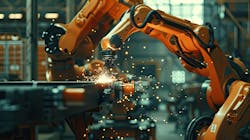Motion Control is Not About to Hand the Reins to AI, But…
“The path from here to there is not built so much on new technology, but new ways of implementing and combining it.”
This line, clipped from a Machine Design article on the basics of systems engineering harks back to 2001. Should the authors flip through the March/April issue's cover series on motion control technology, they’d say it’s déjà vu.
“Functions that now sprawl over two or three components may end up residing in one; some elements may be gone entirely, dissolved into the fabric of the machine or taken up in software,” noted Lawrence (Larry) Berardinis and Francis Richards back then.
READ MORE: Factory Operating Systems: Software That Supports Making Hardware
They would be struck by the veracity of their expectations when they see how a seemingly novel interdisciplinary approach to motion component design has evolved into fully-fledged strategies that transform components—in some cases to the point of being unrecognizable.
Intended as insights into the design of motion system components, their prognostication proved to be relevant today. Recent iterations in axial flux motors support this assertion. Thought to be more expensive to design and manufacture than radial motors, axial flux topology usually presents unavoidable complexities due to positioning of the stator and windings. Now, solutions based on PCB winding topologies for axial-flux machines offer a viable alternative.
In applications where long-travel motion axes and transfer robots are used, moving motors provide another example. Belt drives are usually configured so the motor remains stationary and drives the belt by way of a pinion.
But this setup limits the motion system’s performance due to belt sag and varying stiffness along the belt length. The hindrance becomes more pronounced as travel lengths exceed 15 meters, explained contributor Michael Everman in a recent article., which unpacks how and why moving motors outperform static motors in long-travel linear motion applications.
READ MORE: Driving Robotics and Embedded Motion Applications with Next-Generation Servo Technology
Similarly, rather than designing a robotic joint from scratch, a design engineer might consider off-the-shelf integrated robotic joint systems. The HPJ joint modules from maxon consist of an EC frameless DT motor, a strain wave gear, a motor encoder, an output absolute encoder, an optional braking device and a high-accuracy position controller board.
New technology advancements are infiltrating legacy components at a rapid clip, too. Endless booth crawls at trade shows and factory visits these past few months have confirmed the occasion is rare where generative AI is not high on the agenda. To be clear, discussions are not about throwing emergent tech at everything. When it comes to industrial components, bringing connectivity to simple devices is seldom about the fraction of data it produces or consumes.
Rather, it’s about the ability to extract data from the device on an integrated network and using it to glean actionable results. This is why the demand for dynamic, adaptive design approaches that enable responsive manufacturing practices and support flexibility in production should now be considered the norm, rather than the exception.
Here’s a thought: It is clear that “build versus buy” technology choices are dependent on many factors, including making trade-offs, but OEMs of all sizes would be wise to cater to immediate requirements while keeping an eye on future requirements.
READ MORE: R&D Spotlight: Certifiable Digital Twin Models for Power Drive Systems
About the Author

Rehana Begg
Editor-in-Chief, Machine Design
As Machine Design’s content lead, Rehana Begg is tasked with elevating the voice of the design and multi-disciplinary engineer in the face of digital transformation and engineering innovation. Begg has more than 24 years of editorial experience and has spent the past decade in the trenches of industrial manufacturing, focusing on new technologies, manufacturing innovation and business. Her B2B career has taken her from corporate boardrooms to plant floors and underground mining stopes, covering everything from automation & IIoT, robotics, mechanical design and additive manufacturing to plant operations, maintenance, reliability and continuous improvement. Begg holds an MBA, a Master of Journalism degree, and a BA (Hons.) in Political Science. She is committed to lifelong learning and feeds her passion for innovation in publishing, transparent science and clear communication by attending relevant conferences and seminars/workshops.
Follow Rehana Begg via the following social media handles:
X: @rehanabegg
LinkedIn: @rehanabegg and @MachineDesign
